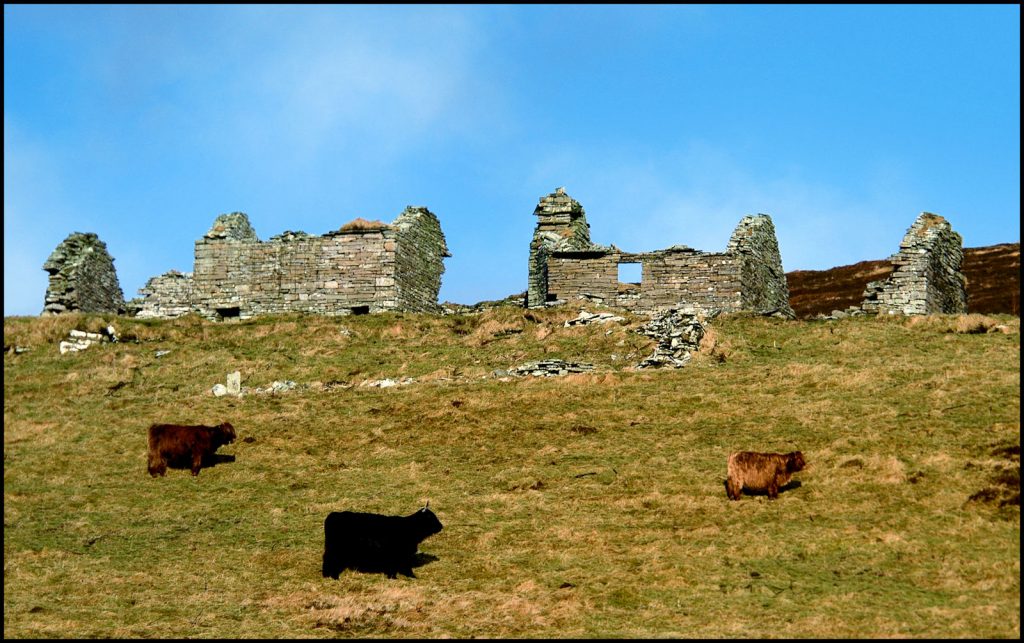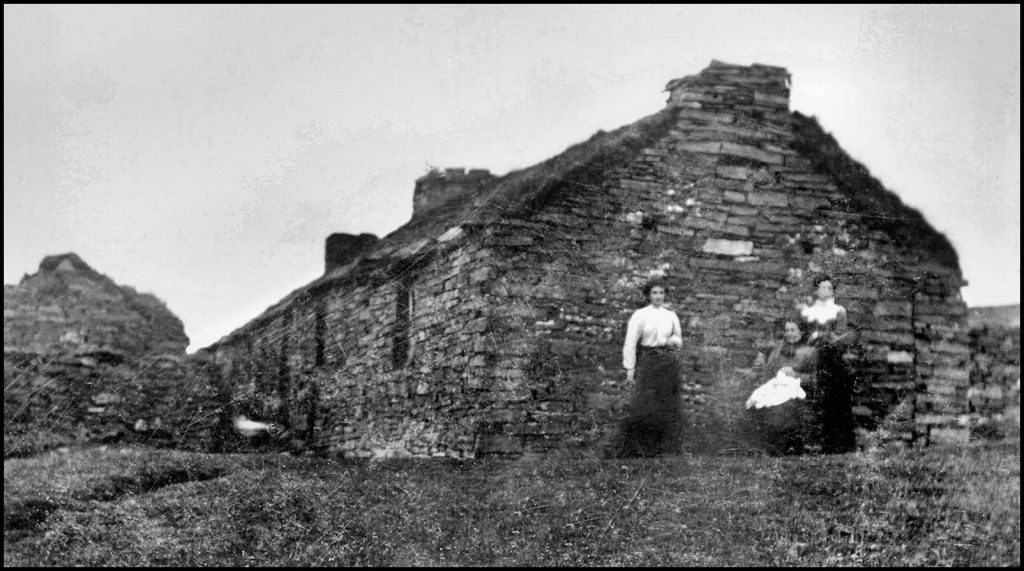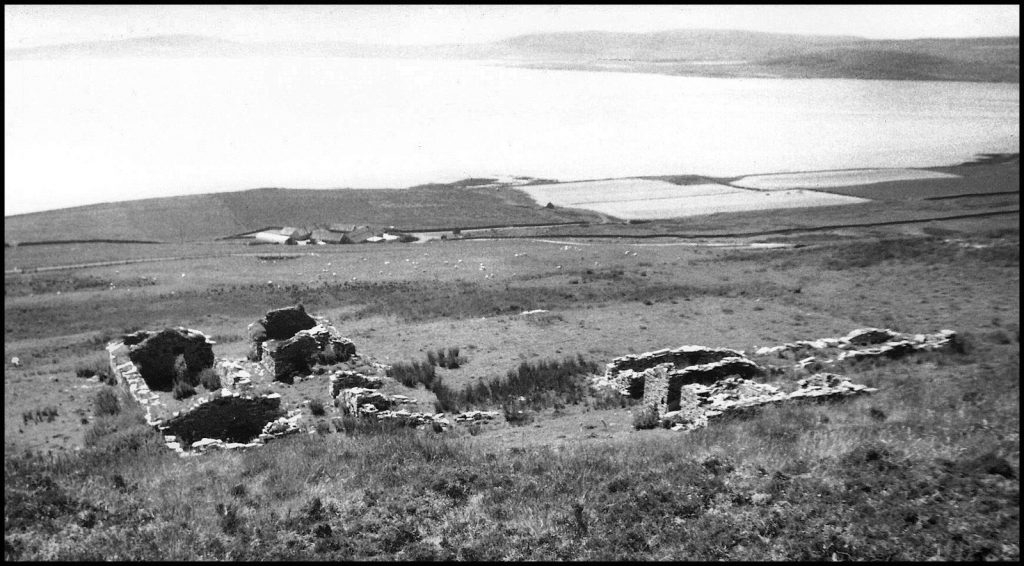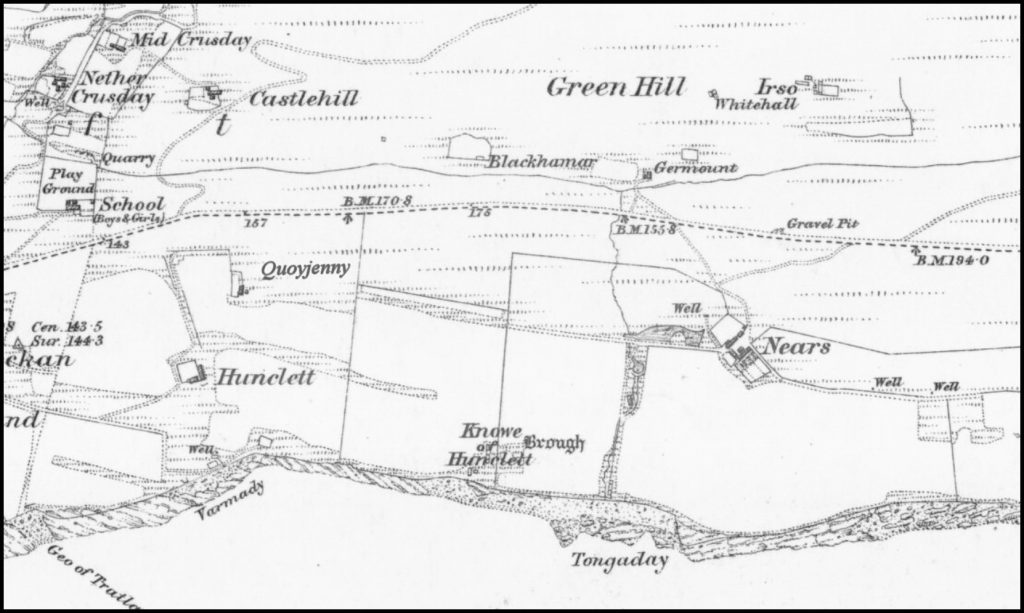Castlehill in Frotoft consisted of three houses, built by James Low for Nearhouse tenant Malcolm Corsie at no cost to the island’s estate in about 1840. Hereabouts was an adjacent field named Ulie Bogie. According to Hugh Marwick in his Place-Names of Rousay the field was perhaps so-named due to its resemblance to the shape of a ulie bogie, a skin vessel for containing oil. The first residents on record here, according to the 1841 census, were 35-year-old Ann Mainland, and 75-year-old pauper Cirstan Sinclair.
At this time James Low lived in one of the houses at Irso with his wife Christina Hourston of Harray and their 4-month-old daughter Barbara. His parents and siblings occupied another house on the same site, but it was not long before the families moved to other premises.
In 1851 James’s father William Low was a seventy-year-old agricultural labourer and lived at Castlehill with his wife Barbara Marwick and their three sons, 31-year-old William and 26-year-old Hugh who earned their living as shoemakers, and 16-year-old John who was still at school. This family lived at Grinnabreck on the Westside before moving to Irso.
James and his ever-growing family had moved to Quoyjenny, a now-vanished house just above Hunclett. He and Christina had six children: Barbara, born in 1841; Jemima, in 1843; James, who was born in October 1848; Margaret, in 1850; William, in March 1852; and Mary, who was born in April 1854.
Toomal is a generic name, surviving as a place-name for a field, and an example of this is the Toomal o’ Quoyjenny. In the old days of the run-rig system, a toomal was the name for a patch of ground which was not shared in common with the rest of a tunship, but was the perpetual perquisite of an individual house in the tunship. Each tunship house had its own toomal, and as such, it received the best of the available manure, and thus became especially fertile.
By the time the census of 1871 was carried out William Low had passed away. Brothers William and Hugh had married, though 51-year-old William was already a widower, his wife Janet Mainland of Crusday having passed away in 1867. He lived at Castlehill with his children Margaret, Jessie, and William, as did his brother Hugh and his 28-year-old wife Ann, who was a midwife. They had two children, Johanna and Hugh. The youngest of the Low brothers John, now 36 years of age was also making a living as a shoemaker there, and their mother Barbara, then in her 76th year, made ends meet by knitting stockings.
Come the census of 1881, shoemaker brothers William and John still lived and worked at Castlehill, but their brother Hugh and his family had emigrated to America. James by that time was in his 64th year and a widower himself. He had moved out of Quoyjenny and was living at ‘Low’s House’ in Frotoft with 30-year-old daughter Margaret and her 26-year-old sister Mary. In 1873 Mary married James Corsie, son of Malcolm Corsie and Isabella Louttit of Nears, but he died in Kirkwall at the age of 42 – his son James Sinclair Corsie being born six months after the father’s death.
Quoyjenny [spelled Curjinny in the census return] at this time was occupied by 62-year-old Rebecca Marwick and her 56-year-old sister Janet, both unmarried, and both employed as agricultural labourers. They were the daughters of Rowland Marwick and Anne Craigie of Nears. It was not long after this that Quoyjenny was demolished.
At the turn of the century former dressmaker Margaret Low had moved from Low’s House and was boarding at Grain, Wasbister, with Hugh and Isabella Marwick and their family. James Low, by then 84 years of age, had moved with his daughter Mary, living at Lower Banks in Frotoft [where Yorville is today]. That left John Low, then a 66-year-old retired shoemaker, and Margaret M Corsie, a 37-year-old widowed dressmaker living under separate roofs at Castlehill. Margaret was William and Janet Low’s daughter, and had married William Corsie of Lower Crusday, but he died in 1899 at the age of 42.
Other vanished houses in this vicinity were Crody and Germount.
Crody was a dwelling close to Castlehill and Germount above Nears in Frotoft, and its first known occupant was James Costie in 1829. In 1841, Janet Marwick, described in the census as a pauper, and her 12-year-old son John lived there. She was the daughter of Rowland Marwick and Anne Craigie of Nears and was born on May 20th 1824. She and her elder sister Rebecca lived at nearby Quoyjenny in 1881, and in 1891 Janet was back at Crody with another elder sister, Mary.
Germount was an old house above Nears in Frotoft, alternatively known as Cathole. In 1841, 25-year-old straw plaiter Ann Marwick lived there, as did 65-year-old pauper Barbara Craigie. Another tenant was William Logie, a 45-year-old farmer, who lived there with wife Janet and eight-year-old son William. Living with them was Cirstan Craigie, a 90-year-old pauper.
In 1851 Barbara Craigie still lived at Germount, but the census put her age at 82 and she was employed as a spinner of wool. The only other tenant there then was Hugh Mainland, a 29-year-old agricultural labourer and fisherman. He was the son of William and Sicilia Mainland of Banks at Sourin, born on April 15th 1822. He married Margaret Craigie of Watten, Egilsay, and they had three children; Mary, born in 1847, John, born in 1851, and Eliza Craigie, who was born in 1855, but she died at the age of six.
The house was spelt Geramount in the census of 1861, and was occupied by 30-year-old ploughman William Corsie and his family. He was the son of Malcolm Corsie and Isabella Louttit of Nears, born on August 24th 1830. In 1853 he married 20-year-old Ann Leonard, daughter of Peter Leonard and Isobel McKinlay of Digro. Between then and 1860 they had five children; Margaret, Annie, William, Malcolm, and James.
William earned his living as a master tailor, and between 1862 and 1877 he and Ann had produced another eight children; Peter, George, John, Charles, Frederick, Jemima, Jessie and Isabella – a grand total of thirteen offspring.
By 1891 the Corsie family had moved to Brendale and ‘Garmount’ had a new tenant. He was James Marwick, a 66-year-old general labourer. He was the son of James Marwick and Christian Groundwater, and was born on December 13th 1824. He married Eliza Allan, of Greentoft, Eday, in 1854, and between 1856 and 1876 they raised a family of eight children: James Groundwater, Mary Mainland, Jemima Elizabeth, John Craigie, Charles, Eliza, Isabella, and Maggie Ann.



